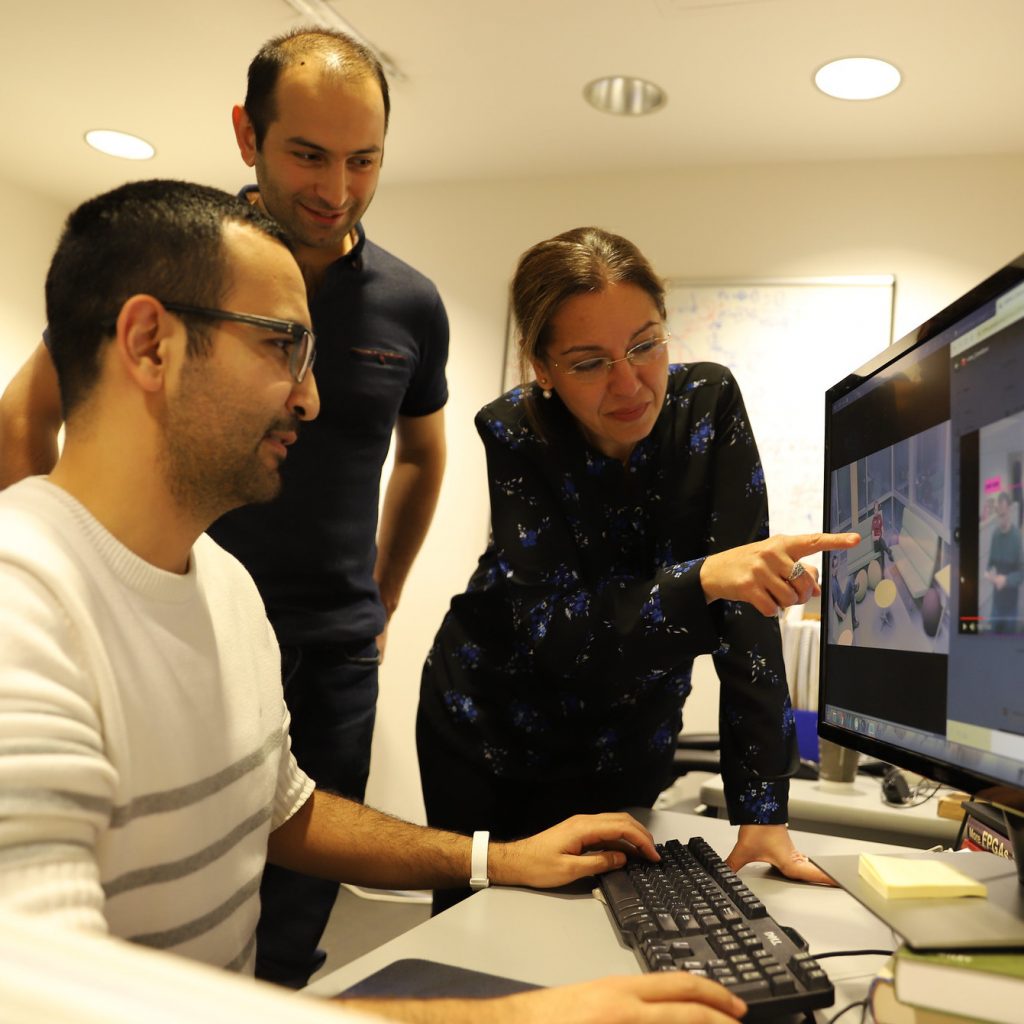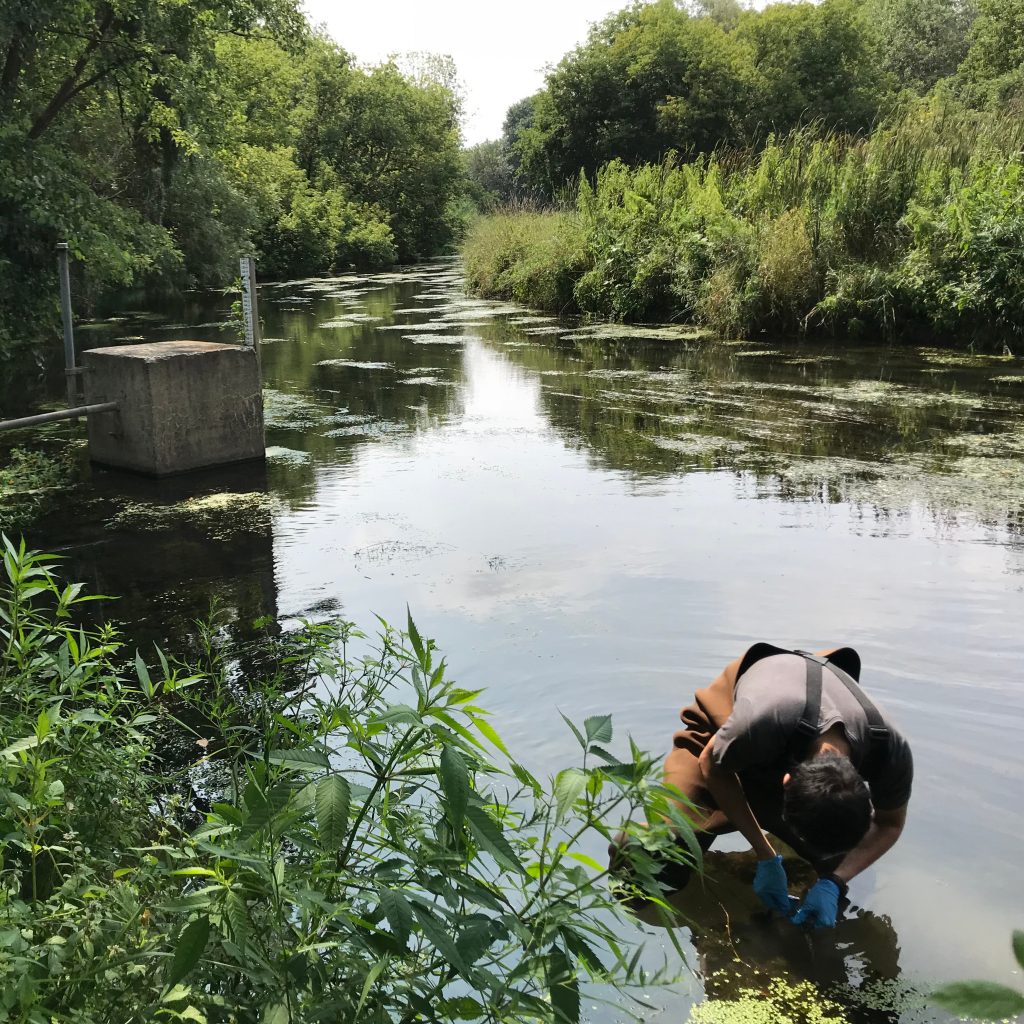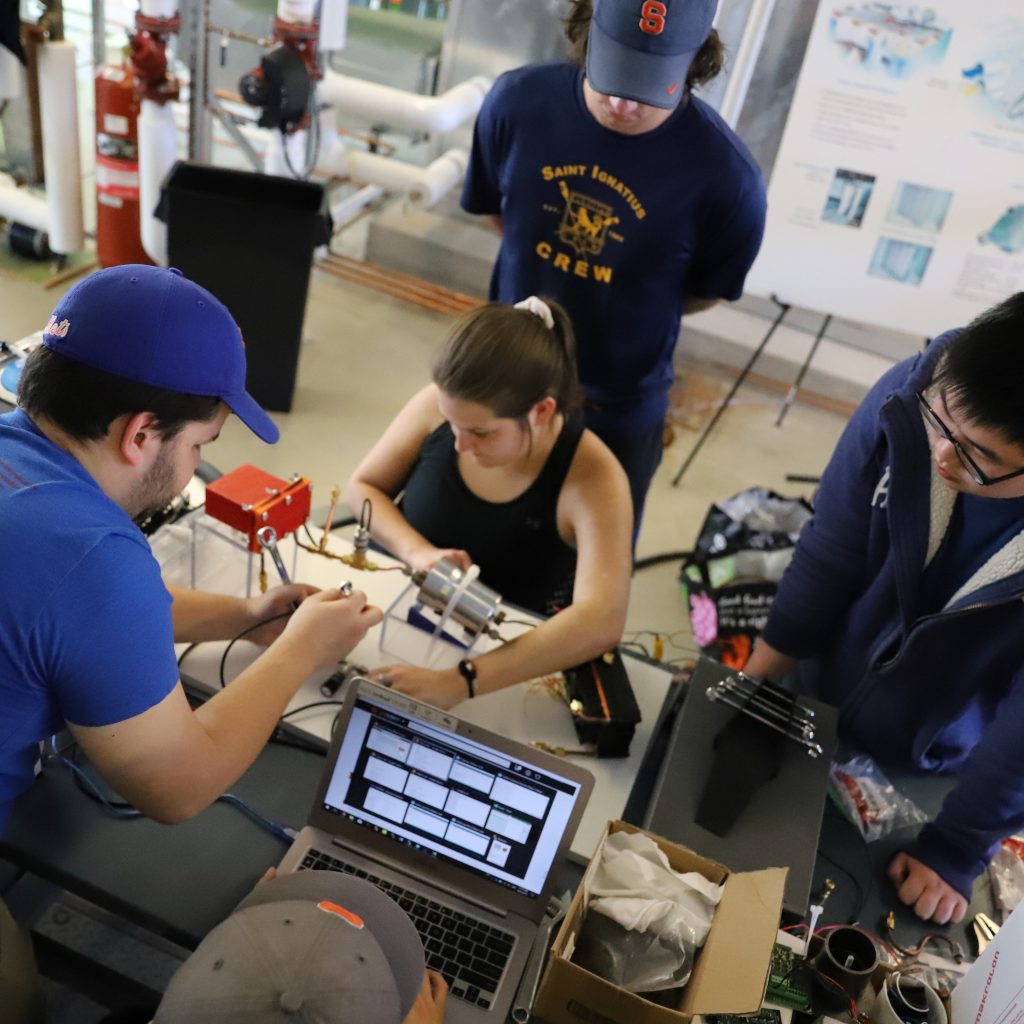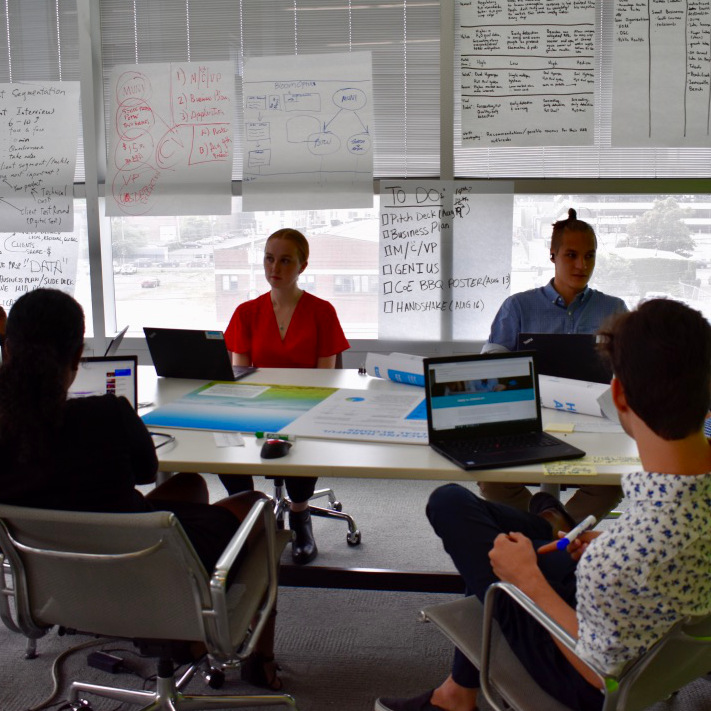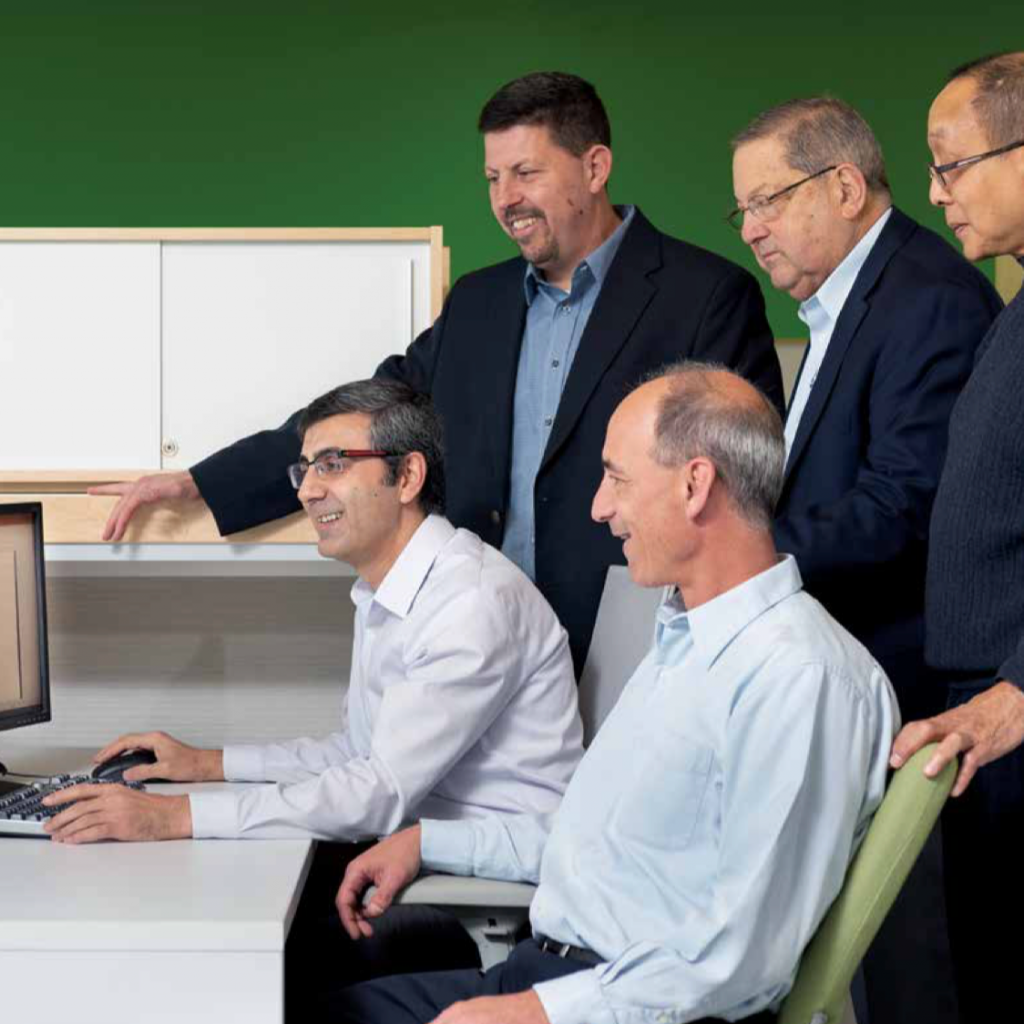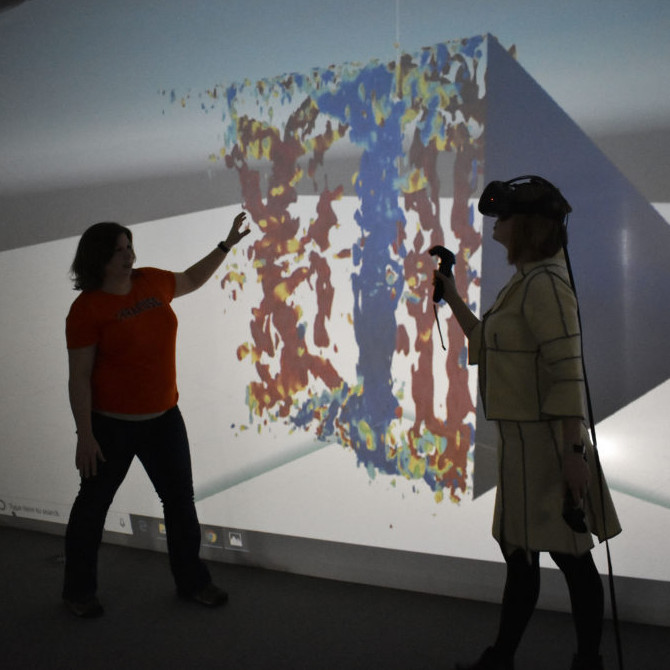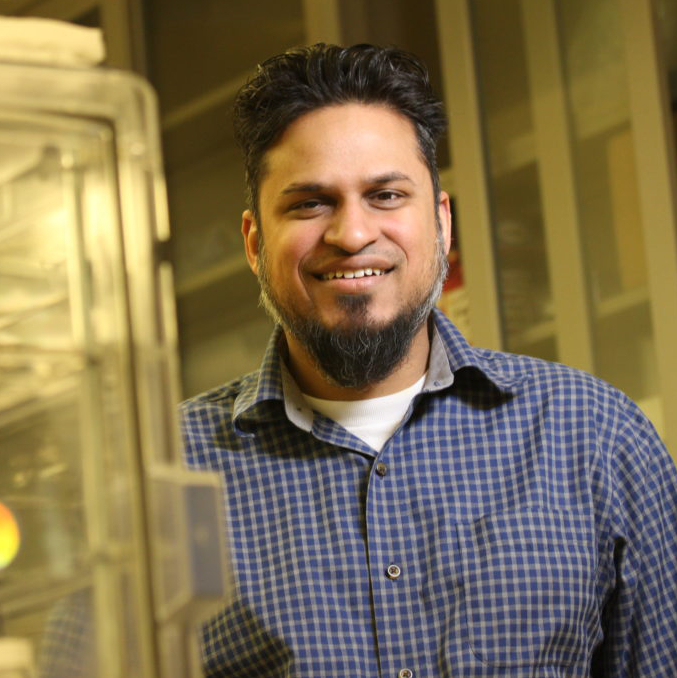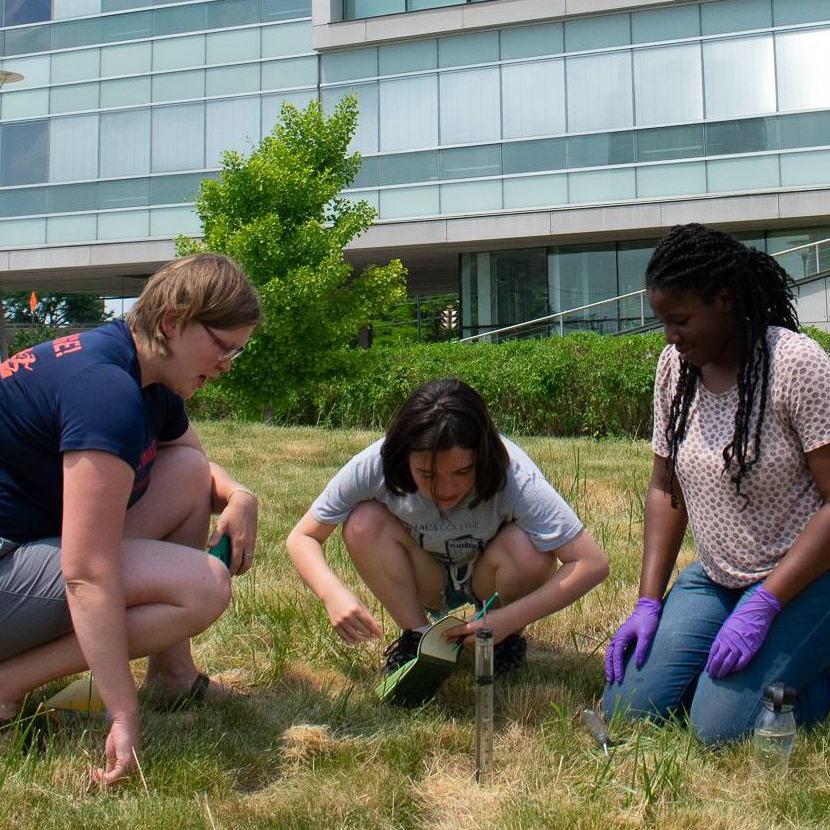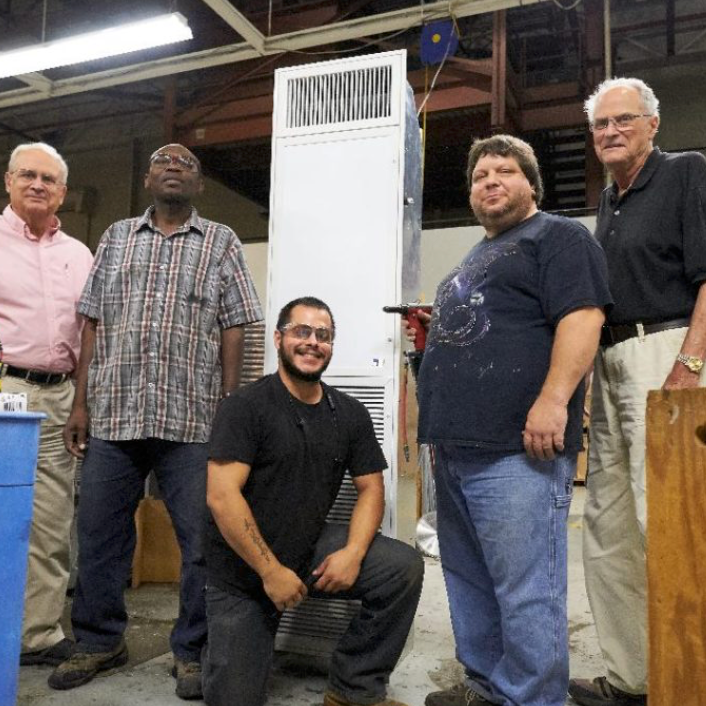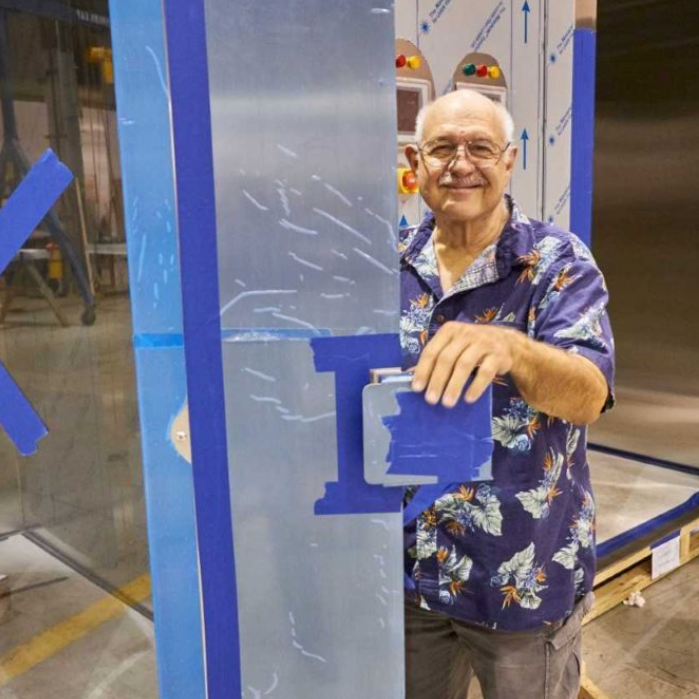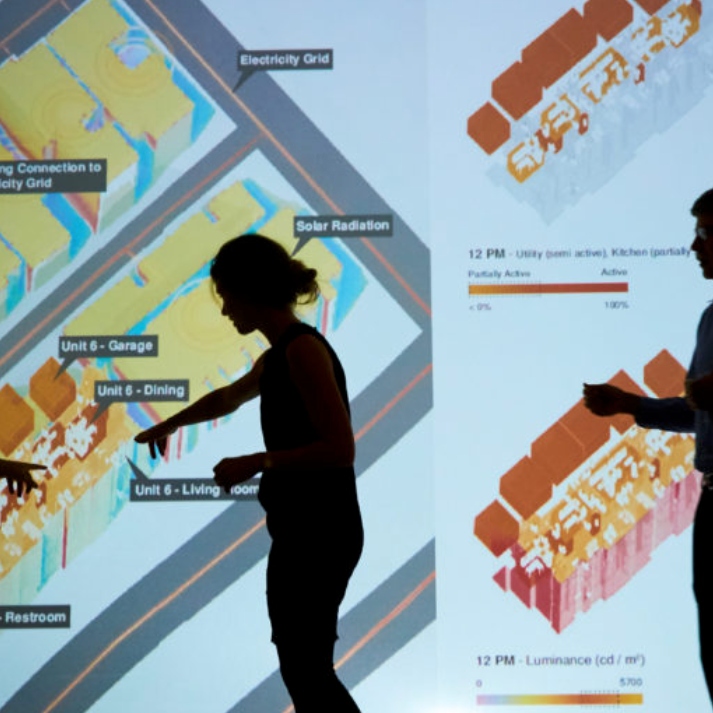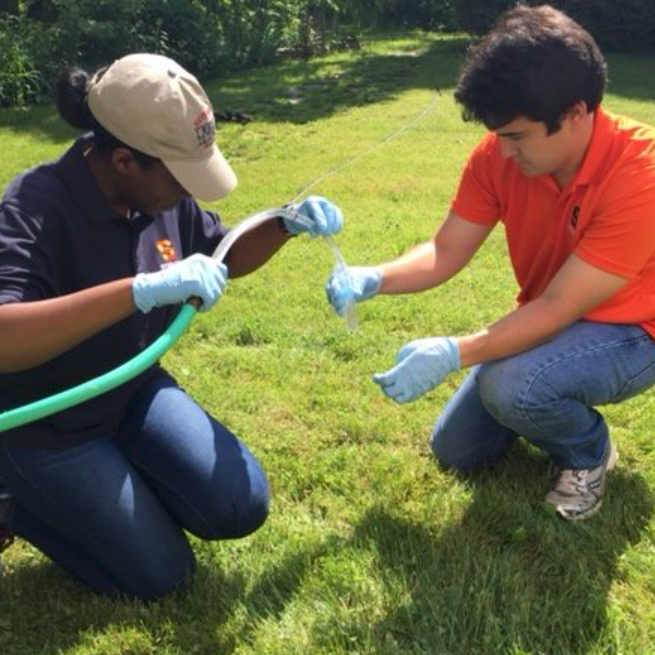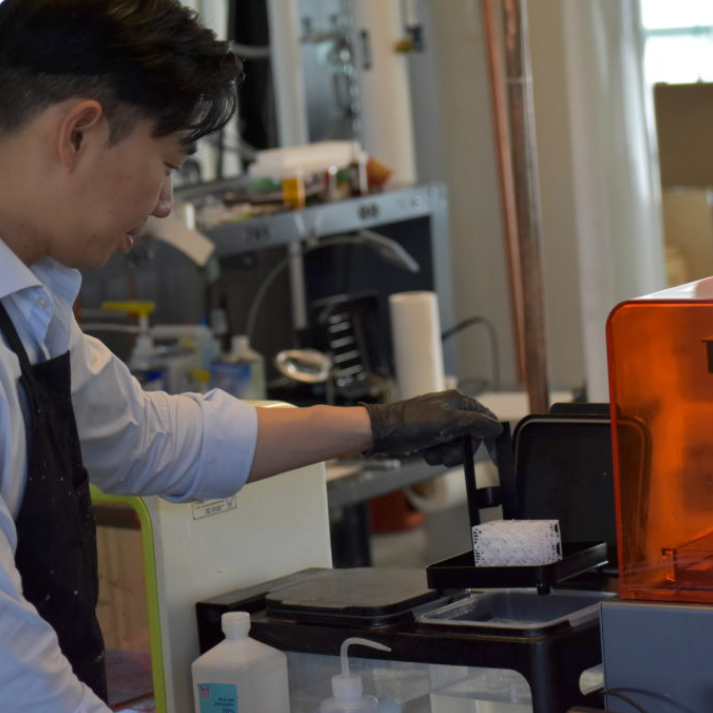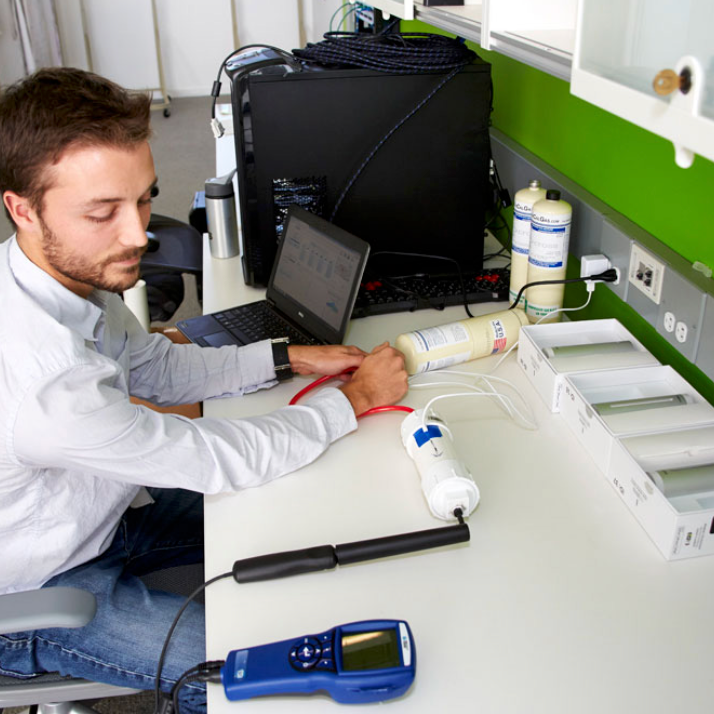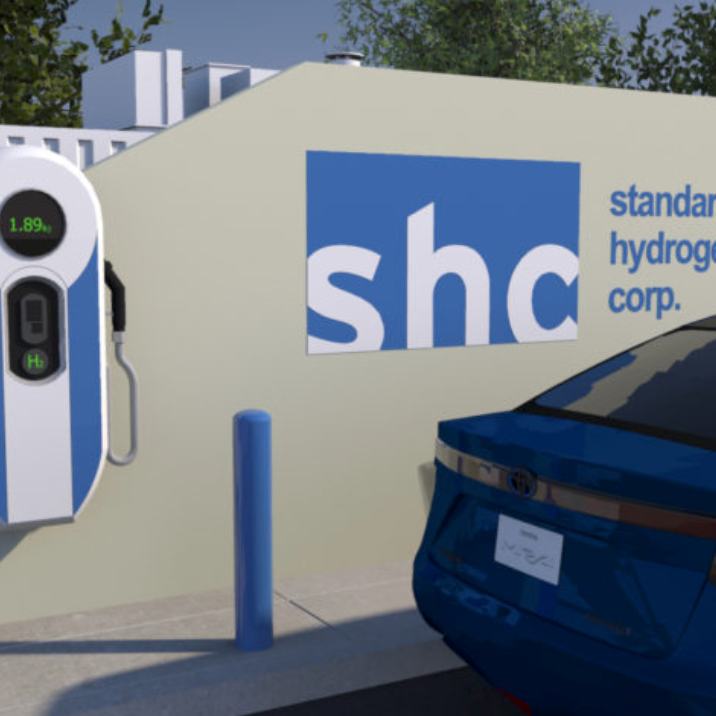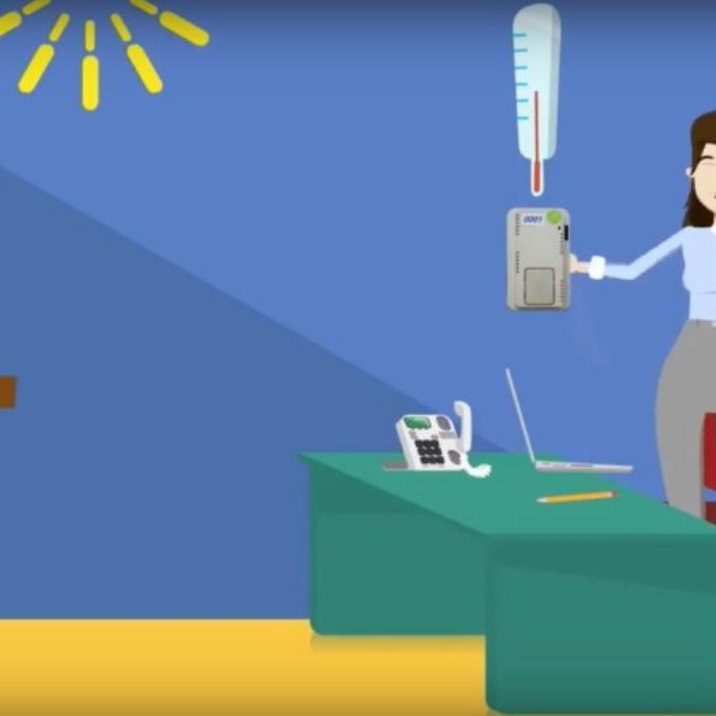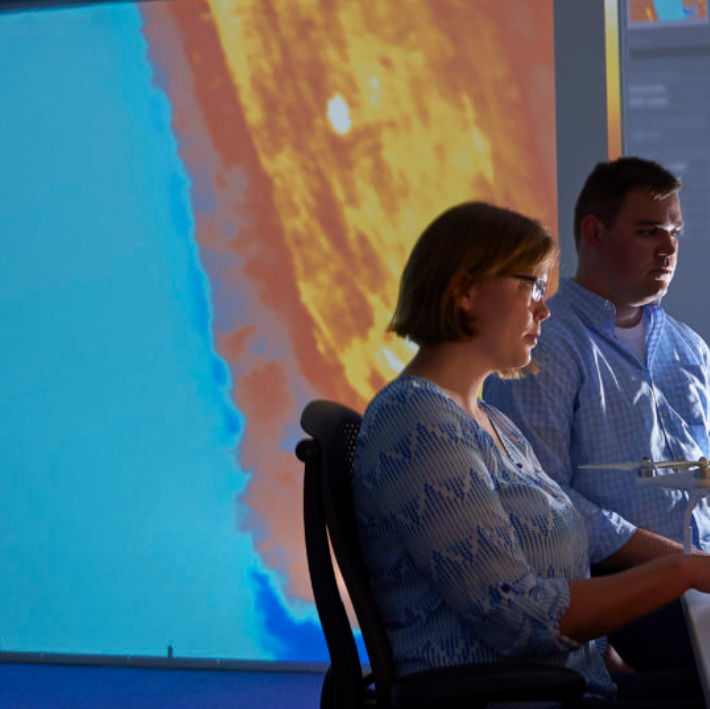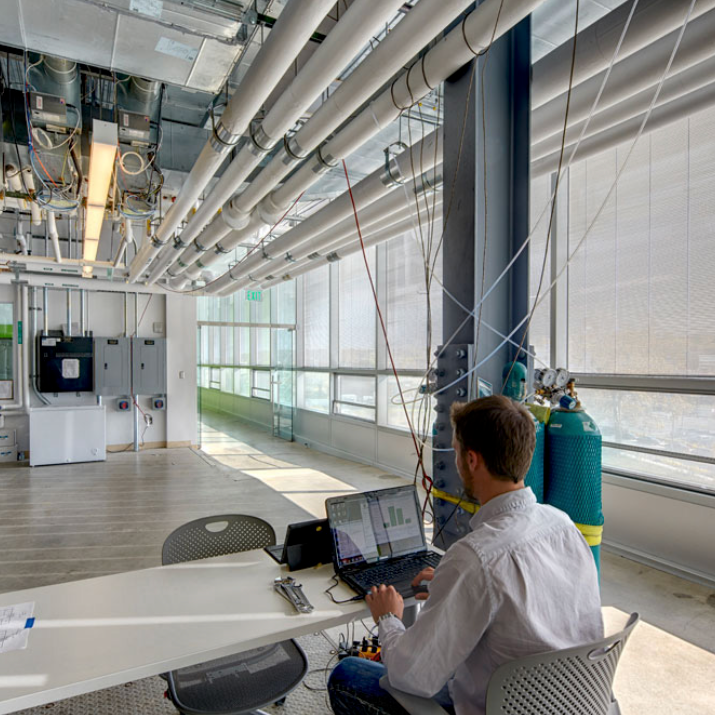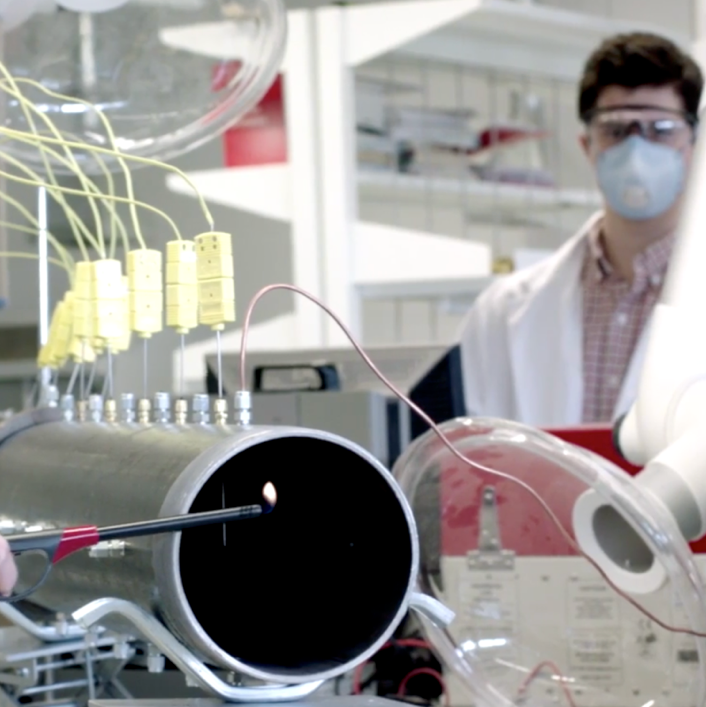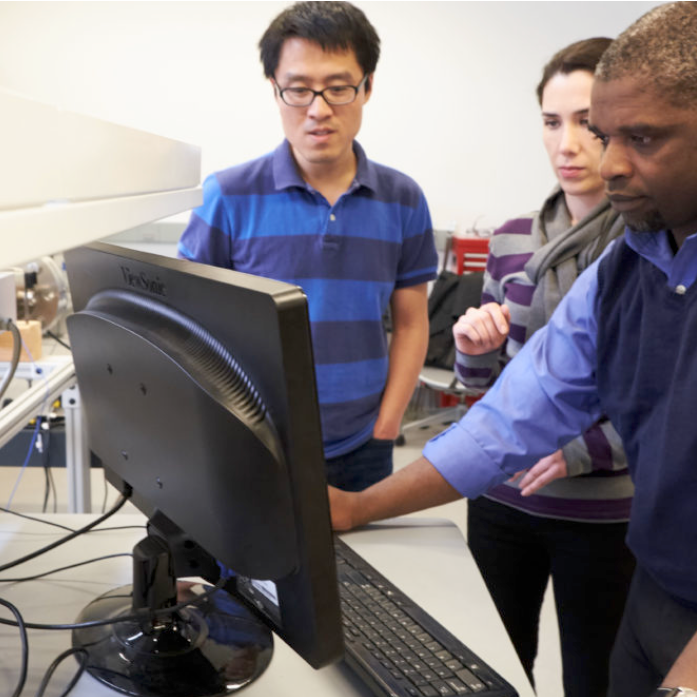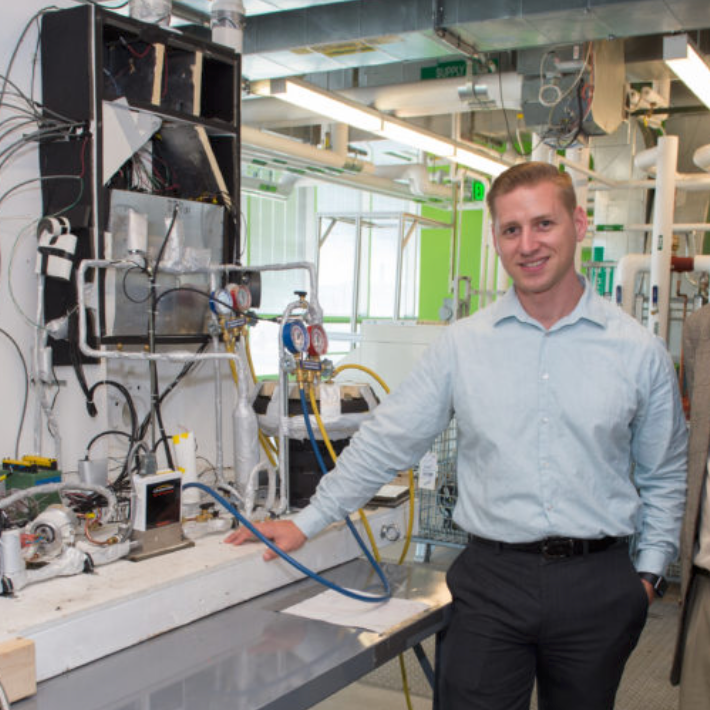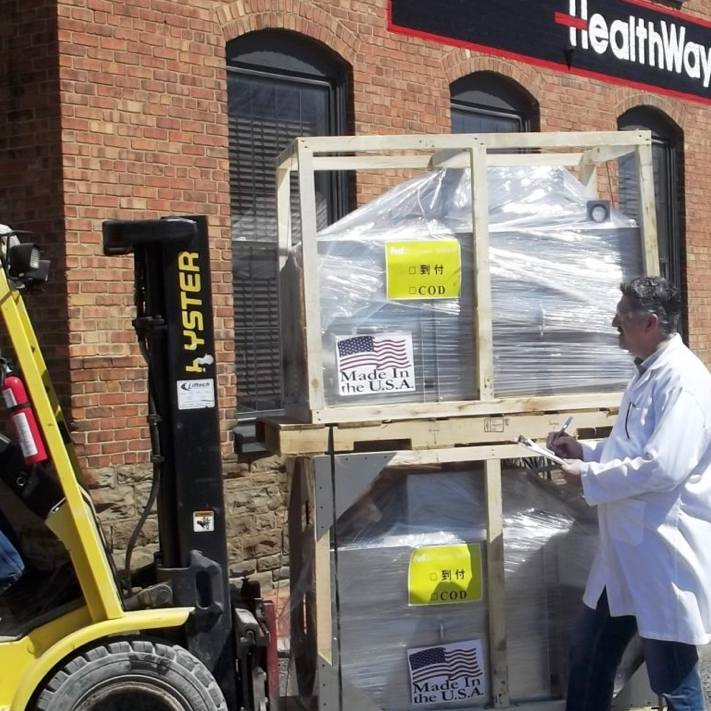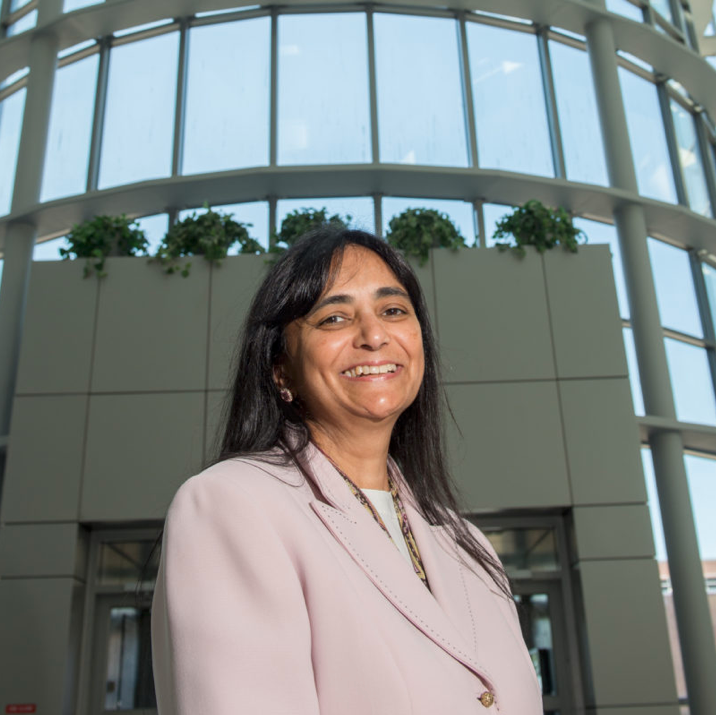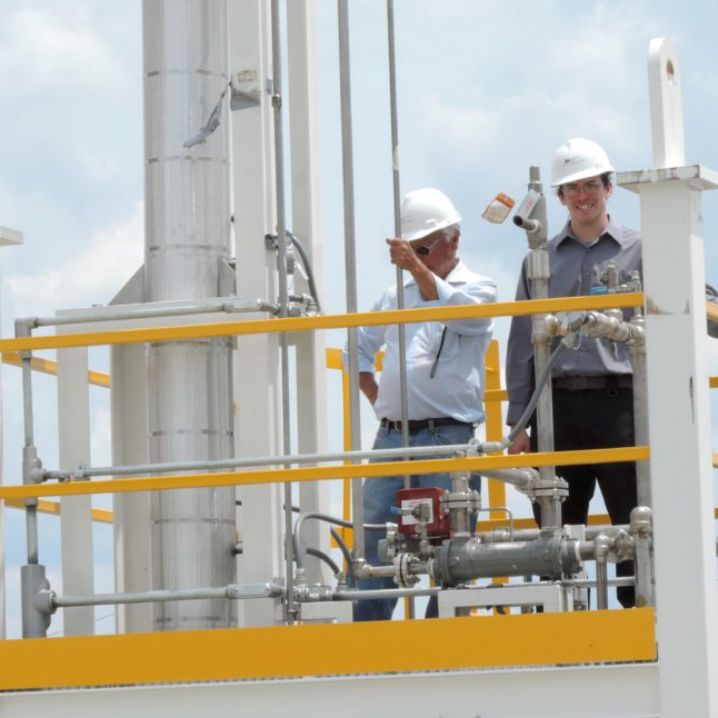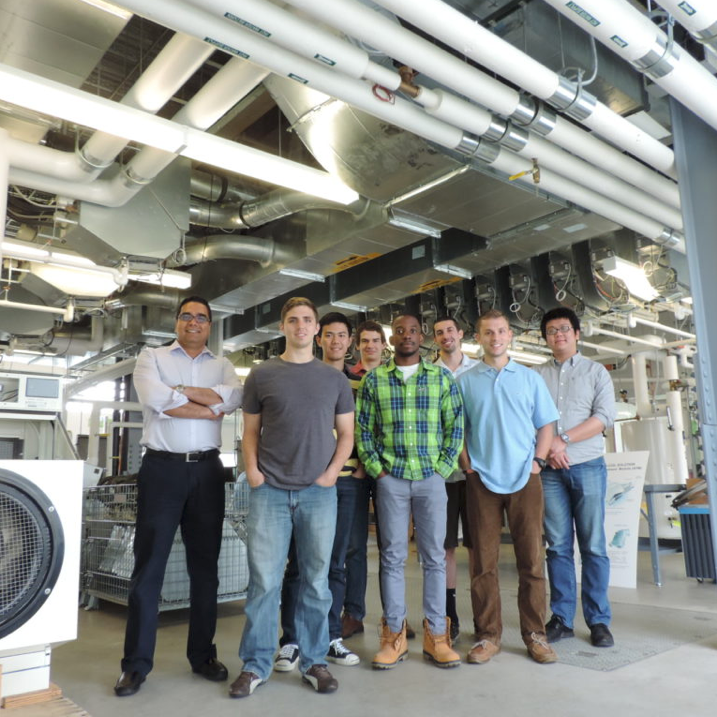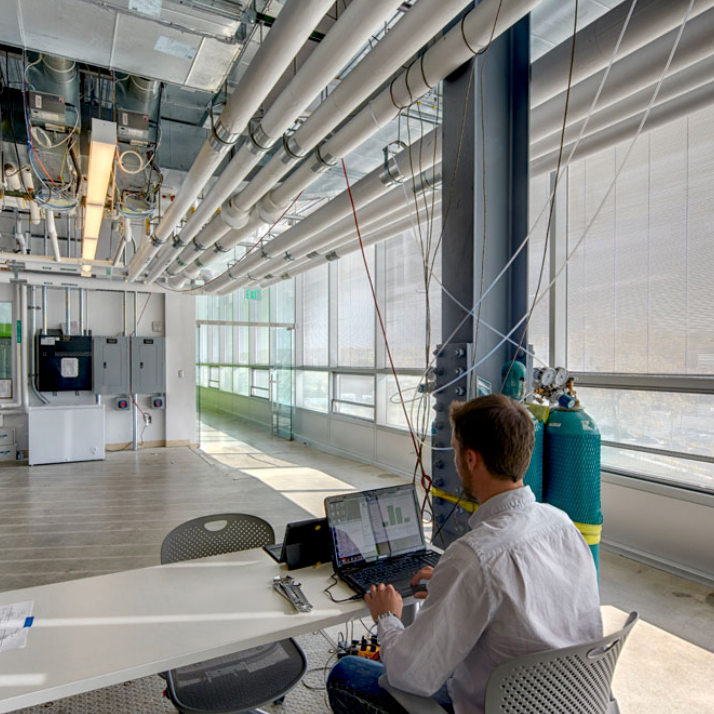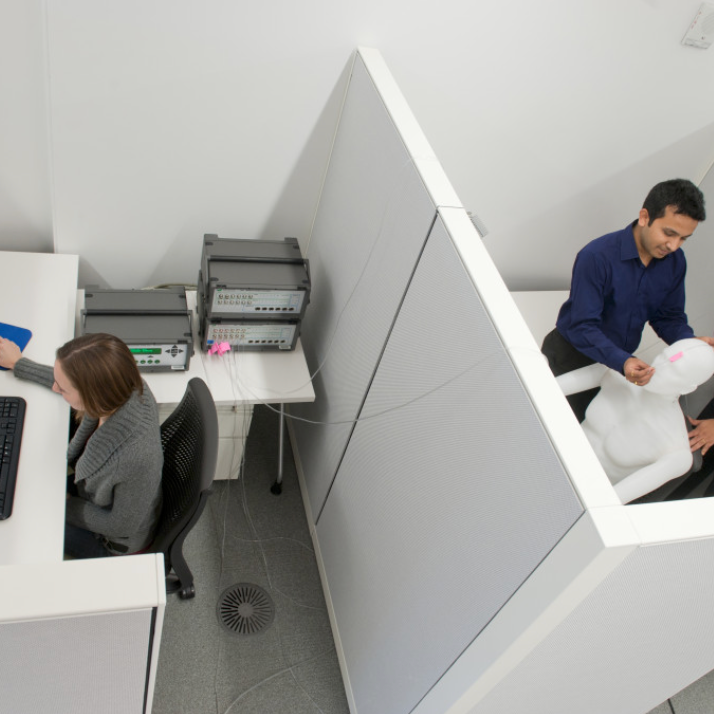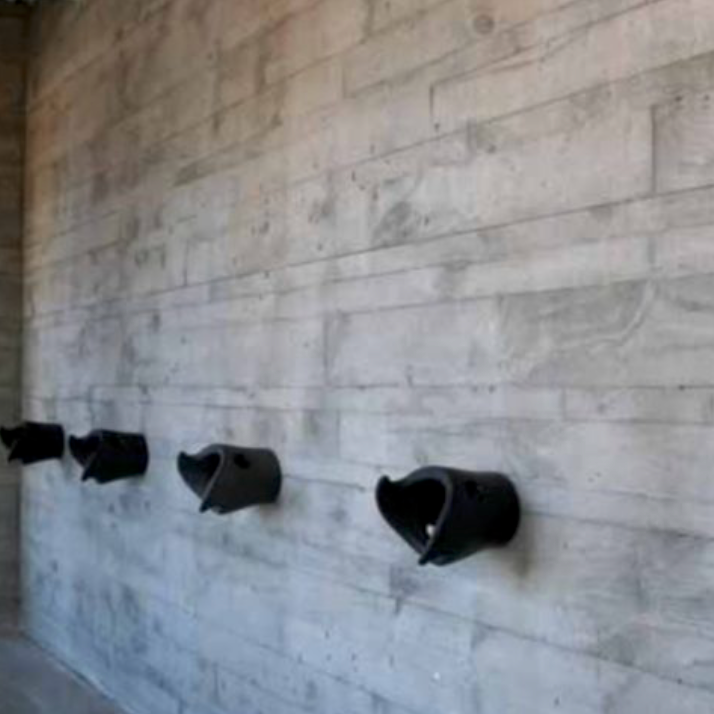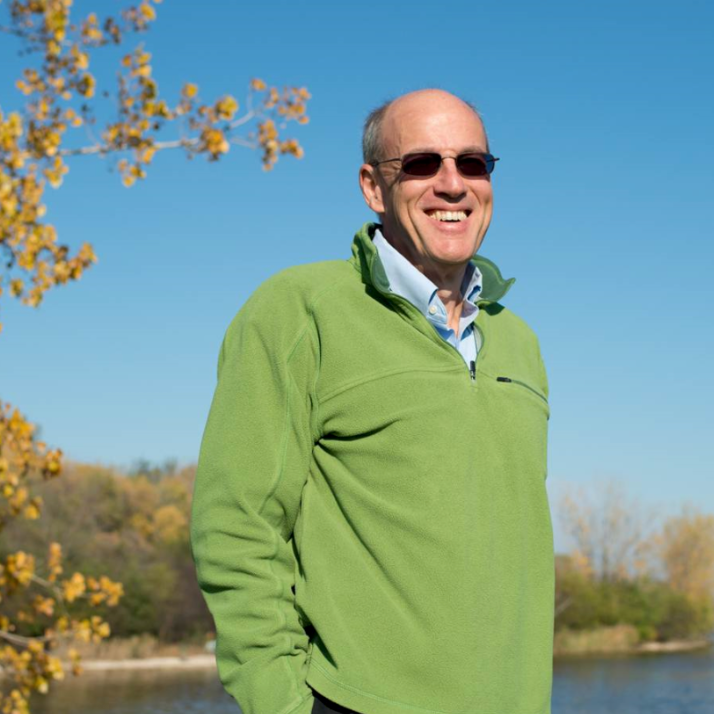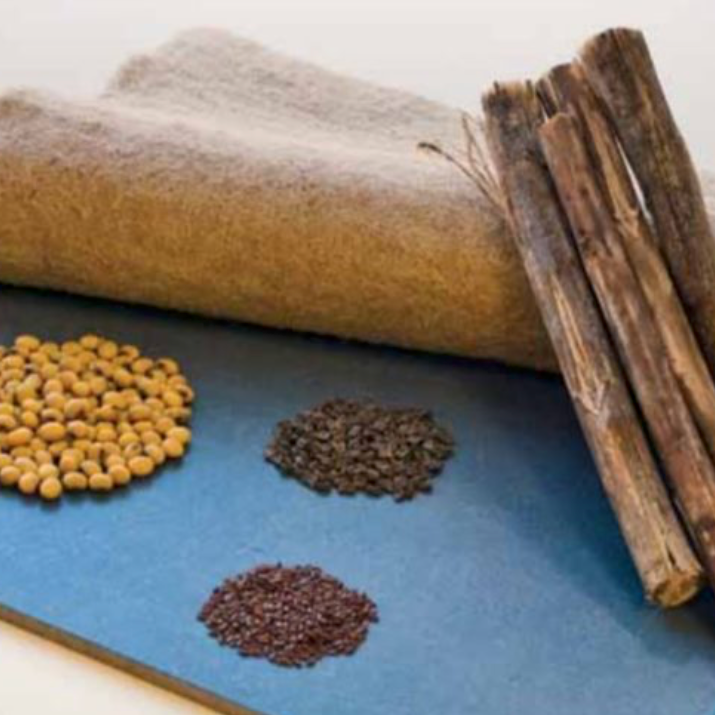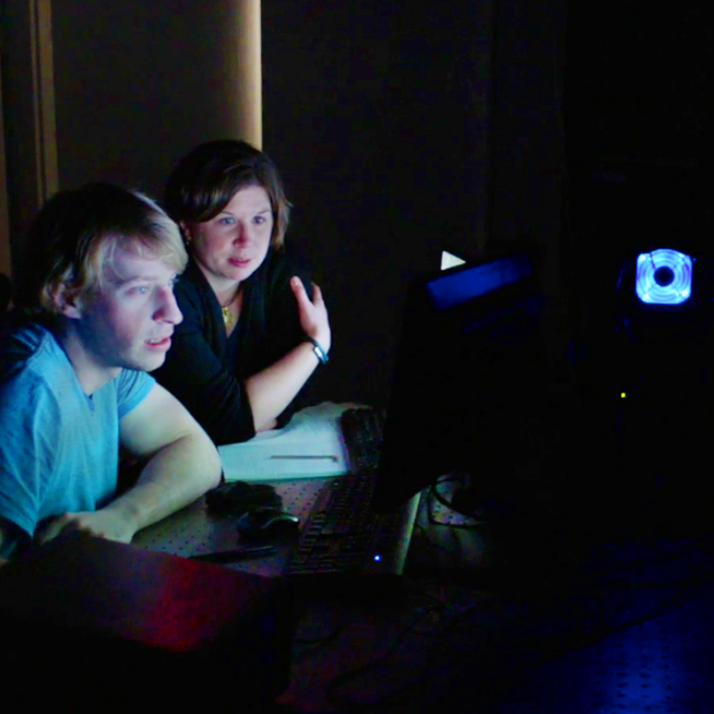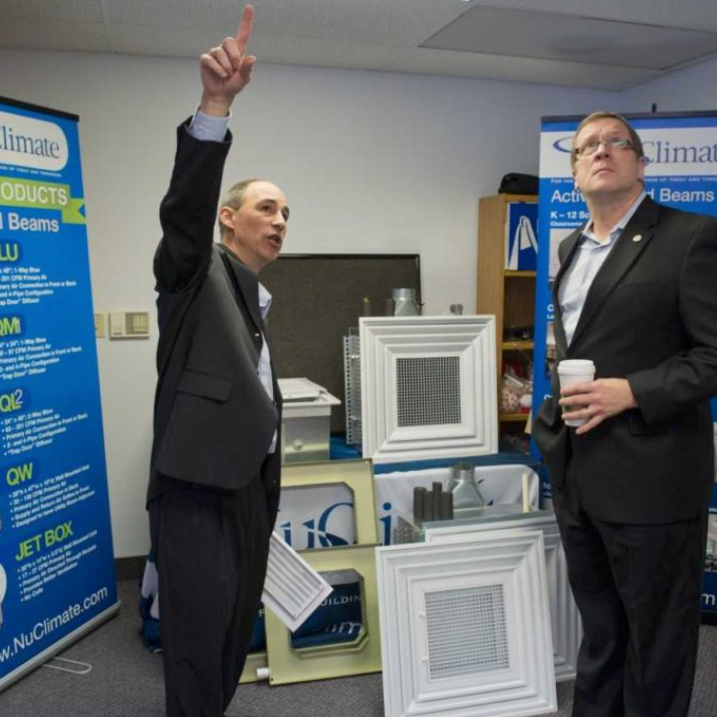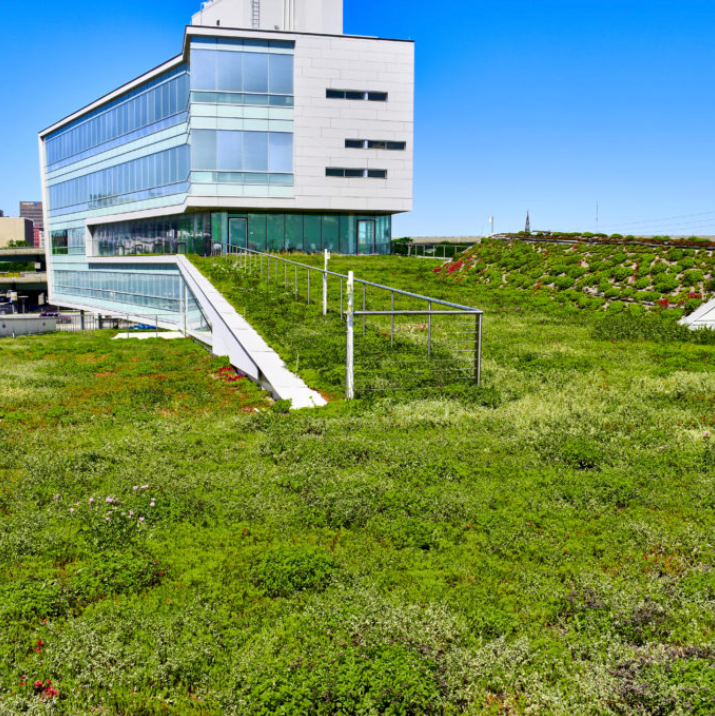Below are selected SyracuseCoE projects that highlight the interface of critical research and industry innovation.
2019
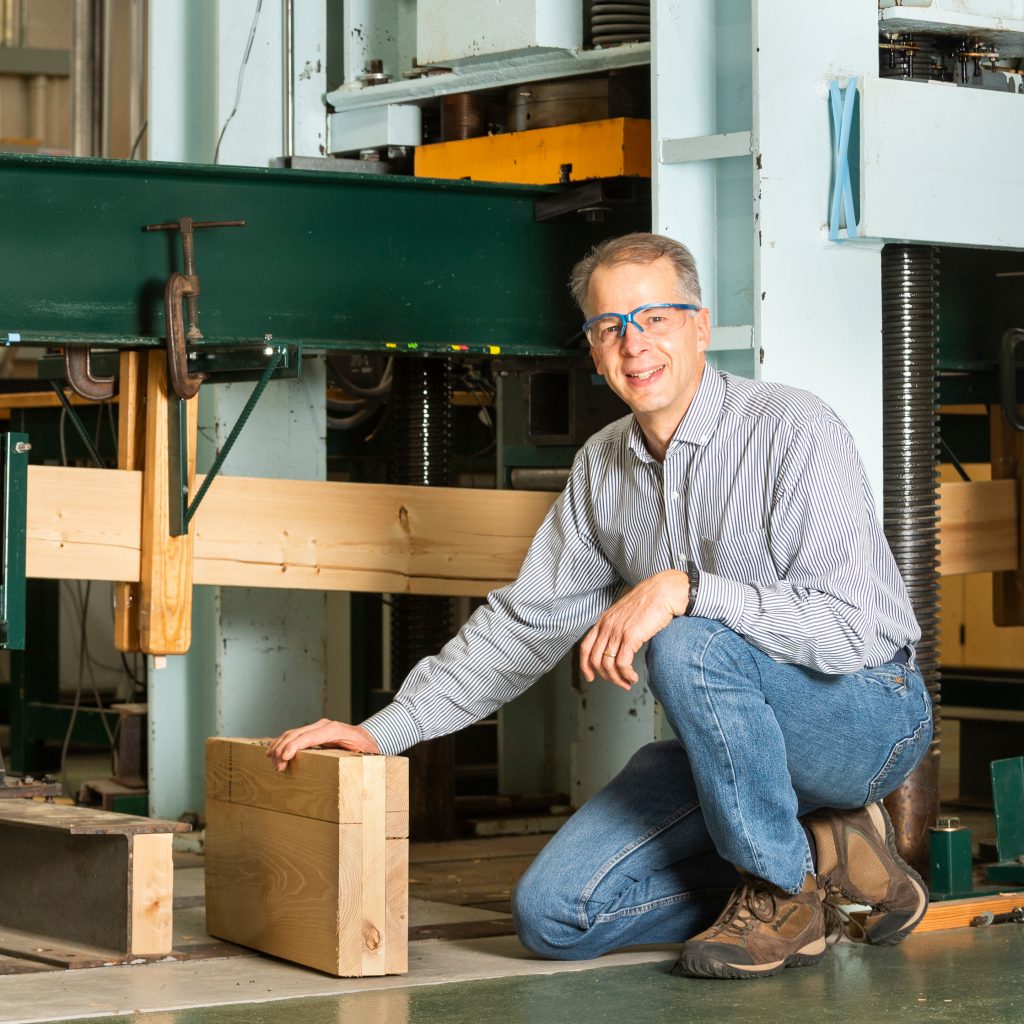
Mass Timber for Sustainable Buildings
Steel and poured concrete production contribute to greenhouse gasses. Building out of wood reduces the carbon impact. SyracuseCoE funding helped this SUNY ESF researcher test wood suitable for mass timber construction in commercial buildings.
Paul Crovella, Ph.D., Assistant professor of forest and natural resources management, SUNY College of Environmental Science and Forestry.
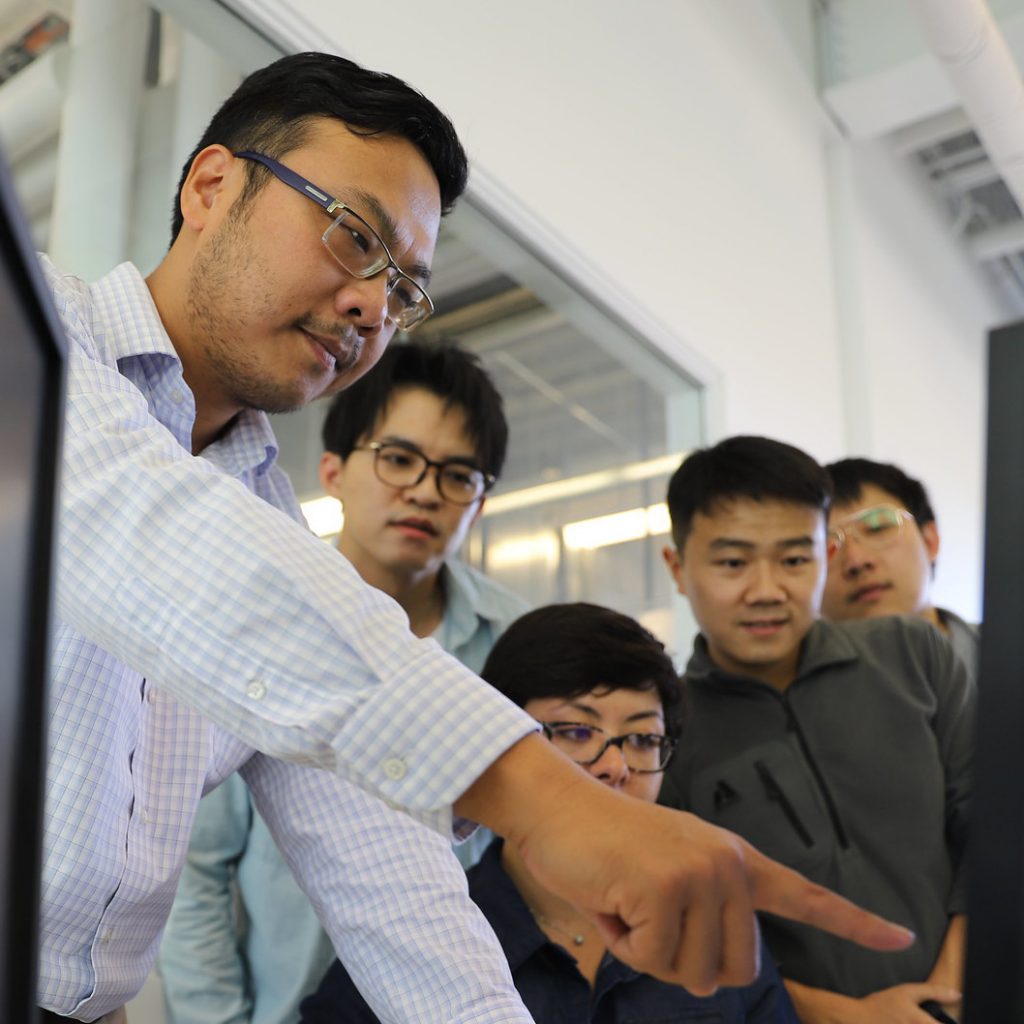
Battery Storage Systems for Buildings
Bing Dong, Ph.D., Associate professor of mechanical and aerospace engineering, College of Engineering and Computer Science, Syracuse University
2018
2017
2016
2012
2010
Characterizing Non-Point Salt Contamination To Streams and Groundwater
While not particularly thought of as a health hazard, high levels of salt are being found in streams and groundwater—affecting our watershed and therefore our overall water quality. Through SyracuseCoE-funded research conducted in Fishkill Creek in Dutchess County, NY, Stuart Findlay of the Cary Institute of Ecosystem studies, along with Don Siegel and Li Jin of Syracuse University, found that the major culprits are road salt (contributing to more than 80% of the issue), water softeners (5-10%) and wastewater treatment plants (about 1%)… READ MORE
Biosensors with Low Cross-Reactivity for Waterborne Contaminants
Dr. Philip Borer, CEO of AptaMatrix, Inc. and chemistry professor at Syracuse University (SU), has conducted research to develop a new method to identify nucleic acid sequences—short strands of DNA or RNA—attracted to microorganisms. Borer calls this Direct Sequence Analysis, or the DSA Method. Using this new method, Borer’s team can quickly find the DNA/RNA strands, called “aptamers,” that recognize and bind to chlorine resistant waterborne microorganisms—such as Cryptosporidium and Giardia—which cause debilitating illnesses that can be fatal for infants, senior citizens, or immune-compromised individuals… READ MORE
Ultrafine Particles and Cardiac Responses: Evaluation in a Cardiac Rehabilitation Center
Epidemiologists study the factors that affect the health and illness of populations. These doctors and scientists know from years of research that particulate matter air pollution causes people to suffer from some forms of heart disease which, for some, can have fatal consequences.
But what is causing this? The term “particulate matter” (PM) describes a wide range of particles, and what isn’t clear is the direct effect of specific particulate matter components. Determining exactly what role each different component found in PM pollution—organics, metals, ultrafines, etc —plays in our everyday cardiovascular health is what Mark J. Utell, with the help of the University of Rochester, is measuring. Researchers suspect ultrafine particles, the very smallest of these particles at less than 100 nanometers in diameter, play a significant role in causing ill health… READ MORE
Integrated Energy Recovery Ventilation and Air Purification System (HEPAiRx)
For adults and children suffering from asthma and other upper respiratory illnesses, clean air can mean relief and feeling better. However, in recent years, energy efficiency requirements have resulted in tighter building construction and renovation. While this has helped conserve energy, a resulting decline in indoor air quality may be a cause for the increase in asthma and upper respiratory illnesses. North Syracuse, NY, company Air Innovations, a SyracuseCoE Silver Partner, believes this situation can be corrected… READ MORE
An Intelligent Urban Environmental System (i-UES) for Central New York Water Resource Management
A unique three-year longitudinal and vertical study of Central New York’s Three Rivers system—involving the Oswego, Oneida and Seneca rivers—has revealed that oxygen resources have become degraded by several stressors, including the impact of wastewater treatment plants, nonpoint runoff, an increase in invasive zebra mussels and channelization of the fl ow. As oxygen is necessary to support life in aquatic ecosystems, its measurement is essential for gauging the overall state of water bodies; in one of the study’s surveys, more than one-third of the 90-kilometer length of the river system failed to meet the New York water quality standard… READ MORE
Commercializing “Q” Air Terminals: Addressing Challenges of Indoor Air Quality, Energy Costs, and Health Risks
Keeping the air in an office, dormitory, laboratory or school at a comfortable temperature and free of germs and odors requires lots of energy. NuClimate Air Quality Systems has designed equipment to address both indoor air quality and energy concerns. The product, consisting of induction units/ chilled beams, is called the “Q” Air Terminal. “Q” stands for “Quality… READ MORE
Bridging the Temporal Mismatch between Remotely Sensed Land Use Changes and Field-Based Water Quality/Quantity Observations
As urban development continues to expand outward, cities and suburbs are losing permeable surfaces to sidewalks, roads, and parking lots. By taking natural hydrology out of the equation, we are faced with negative impacts on water quality from storm water runoff.
Runoff moves swiftly over impervious surfaces, picking up dirt and contaminants as it flows to the nearest water body. Runoff also puts pressure on sewer lines, which can breach capacity during storms, releasing a mixture of raw sewage and runoff directly into a nearby waterway before reaching a plant for treatment—known as combined sewer overflows… READ MORE
Integrated Computer Simulation Environment for Performance-Based Design of Very-Low Energy and High-IEQ Buildings
The US Department of Energy (US DOE) has announced a $560,296 grant to a Syracuse University (SU)-led project to develop a virtual design studio to help building designers evaluate architectural and mechanical options in order to maximize the energy savings of residential and commercial buildings while ensuring healthy, comfortable and productive indoor environments.
The Virtual Design Studio project is led by Jensen Zhang, L.C. Smith College of Engineering and Computer Science, and Michael Pelken, SU School of Architecture. The project is being developed in collaboration with Syracuse-based firm and SyracuseCoE building Patron and tenant CDH Energy, the Florida Solar Energy Center and SyracuseCoE, which provided matching funds… READ MORE
Life Down Under: The Forgotten Hyporheic Zone in Stream Restoration and Development of a Bioindicator of Subsurface Recovery
Billions of dollars are spent every year on stream restoration projects aimed at restoring the hydraulic and ecological diversity of natural stream systems. Usually restoration goals are focused on bank erosion and improving fish habitat. But, what effects are there on the subsurface environment? Streams are not simply surface flow over a stream bed, but include complex interactions with and within the stream bed. What effects do these man-made rock structures have on biological communities within the bed itself? Do they restore the habitat and biological diversity like we hope they do? … READ MORE
Development of a Photovoltaic Cell Utilizing a Proprietary Manufacturing Process
For more than 30 years, solar photovoltaics (PV) technology has tried to feasibly compete with coal-fired power generation as a source of grid tied electricity—with limited success. However, with continued advancements in technology and the rising price of fossil fuel-powered energy, a path to grid parity for solar PV exists. Some analysts argue that 100% of our current energy demands could be met with a mere 1% of our land area blanketed with solar cells. For these reasons, grid-connected solar PV represented the fastest growing energy technology on the world market through 2009. The question is—how do we reduce the cost of producing solar PV while increasing production throughput? Syracuse University partner Antek is working to solve this dilemma… READ MORE
Distributed Demand Controlled Ventilation for Improving Indoor Air Quality
The interest in controlling Indoor Air Quality (IAQ) stems from the desire to create and maintain healthy and safe work environments for the many people around the world who work in office buildings. This means being able to immediately detect the presence of pollutants and contaminants, alert those in charge, and mitigate the problem or reduce the impact on the indoor environment… READ MORE
Open Web Services-Based Indoor Climate Control System
How often have you sat at your desk—at work, in school, at a computer lab—and felt uncomfortable with your indoor environment? Is air too warm and stuffy, or too cold to concentrate? Even worse, the reason we often feel too hot in the winter and too cold in the summer is because of HVAC systems that are wasting energy by over-conditioning the building. While building automation systems (BAS) that deal with these problems have existed for a long time, they currently do not take advantage of the Internet technologies that transformed many other computing domains—and that are user-friendly for office workers, students, and general public alike… READ MORE
CDH Energy To Monitor Green Homes
SyracuseCoE Patron CDH Energy has partnered with SyracuseCoE to install monitors in all three of the innovative green homes built as part of the Near Westside Initiative. These homes are the result of the “From the Ground Up: Innovative Green Homes” competition, built in collaboration with the Near Westside Initiative, Syracuse University School of Architecture, Home HeadQuarters and SyracuseCoE, which fosters advanced thinking about design, sustainability, and cost-effective building practices for the single-family home… READ MORE
2009
Naturally Chilled Water Project Begins Feasibility Study
Introduced in October 2008 by SyracuseCoE Platinum Partner SUNY-ESF, the Central New York Naturally Chilled Water Project (CNYCWP) is in the process of conducting scientific and engineering investigations to determine the feasibility and suitability of bringing naturally chilled water from Lake Ontario to Onondaga and Oswego counties, using existing rights-of-way and new technology to effectively support a large-scale municipal cooling district and other opportunities. The $1.5 million funding for the study was secured through the US Environmental Protection Agency… READ MORE
SU, IBM Break Ground on Green Data Center
In May 2009, officials from SyracuseCoE Platinum Partner Syracuse University, IBM, and New York State broke ground on what will be one of the most energy-efficient computer data centers in the world. With the use of green technologies, the new facility is expected to use about half the energy of a typical data center. US data centers consume more than 62 billion kilowatt hours of electricity annually at a total cost of about $4.5 billion, an amount equal to what 5.8 million US households use in a typical year… READ MORE
SyracuseCoE Opens One-of-a-Kind BEST Lab
Two of Syracuse’s signature strengths—robust, four-season weather and expertise in green building technologies—have attracted an international team to conduct a project that will help improve energy efficiency in buildings through weatherization technologies.
Project partners include the Air Barrier Association of America (ABAA), Oak Ridge National Laboratory (ORNL), the US Department of Energy (USDOE), the New York State Energy Research and Development Authority (NYSERDA), Syracuse University, and the Syracuse Center of Excellence (SyracuseCoE). The partners have committed more than $2 million to undertake the three-year project… READ MORE
Groundbreaking Held for Near Westside’s Lincoln Supply Building
In September 2009, a ceremony was held to commemorate the start of a $3.2 million renovation project of the Lincoln Building, located on the 300 block of Wyoming Street, Syracuse.
The Lincoln Building, formerly known as the Lincoln Supply Warehouse, is a 100-year-old, four story property that will be renovated to create 30,000 square feet of mixed-use commercial and residential space. The renovation will transform the first two floors into commercial space and the top two floors into live/work artist lofts… READ MORE
2008
Tower to Survey City’s Air
In February, a 150-foot Air Pollutant Monitoring tower was raised on the site of the Syracuse CoE headquarters. The tower will be used for a long-term, one-of-a-kind study that will assess Syracuse’s urban air quality, air flow, and how outside air affects air quality inside a building.
Eventually, this air quality data could lead to intelligent building management systems that will tell occupants when it is a good time to open a window and when they should close up because of air pollution… READ MORE
Taitem Demonstrates Split Desiccant AC
Historically, the only way to condition air was to draw it over a cold surface, around 45 degrees Fahrenheit, but Ithaca-based Taitem Engineering, PC has found a way to do it with much warmer surfaces, around 60 degrees Fahrenheit.
In August, a team from Taitem—led by Ian Shapiro—successfully tested the concept of a Split Airstream Desiccant Cooling system at the Building Energy and Environmental Systems (BEES) Laboratory at Syracuse University… READ MORE
Improving Energy Efficiency in Near West Side Homes
An integrated project to help homeowners in the Skiddy Park area of Syracuse’s Near West Side neighborhood assess and improve energy use and indoor environmental quality began in January with the first of as many as 50 families receiving free home energy assessments. Home HeadQuarters is leading the project, with assistance from SyracuseCoE… READ MORE
SyracuseCoE Team to Design High-Performance Homes
Thanks to $550,000 from the New York State Energy Research and Development Authority (NYSERDA) awarded in February, a collaborative SyracuseCoE team will design and build up to six new energy-efficient “green” homes in Syracuse. CDH Energy leads the Home Performance Improvement Challenge (HomePIC). Additional members include the Building Performance Contractors Association, Camroden Associates, Northeast Green Building Consulting, and Syracuse University… READ MORE
Breaking It Down and Building It Up in New Orleans
Members of the Environmental Finance Center (EFC) at Syracuse University learned there’s more than one way to use a hammer when they helped with reconstruction—and deconstruction—of the Holy Cross neighborhood of New Orleans’ Lower 9th Ward.
The EFC was invited in March to observe and evaluate the Historic Green project. Specifically, the team analyzed the components—the people, resources, and plans—involved in this unique recovery project in a neighborhood devastated by Hurricane Katrina in 2005… READ MORE
Bringing Historic Lessons Home
With leadership assistance from Northeast Green Building Consulting and Naef Recycling, SyracuseCoE and Home HeadQuarters are working together on the planned deconstruction of a house in Syracuse’s Near West Side Neighborhood, including workforce development, market development, and policy initiatives needed to support the process. The project expects to provide a framework that engages the community in sustainable urban redevelopment… READ MORE
Maxwell School Students Help Help City of Oswego, US Virgin Islands
The EFC and SyracuseCoE continue their important partnership with the Maxwell School of Syracuse University through the graduate capstone project, a four-week intensive research and development project that caps the one year Masters of Public Administration program.
Supporting SyracuseCoE’s clean and renewable energy focus area, SyracuseCoE and EFC engaged a Maxwell capstone student team that collaborated with the school’s Center of Environmental Policy and Administration to develop a sustainable energy plan for city of Oswego in Central Upstate New York… READ MORE
2007
Chasing Quicksilver Through the Mountains
Professor and SyracuseCoE associate Charles Driscoll and colleagues from the Hubbard Brook Research Foundation (HBRF) and Clarkson University have released the results of two new landmark studies that identify five known and nine suspected biological mercury hotspots in the northeastern US.
The findings suggest that coal-fired power plants in the US are major contributors to mercury pollution. One of the mercury hotspots occurs within New York’s Adirondack Mountains… READ MORE
Near Westside Initiative: Energizing a Neighborhood
On September 21, 2007 Syracuse received a double dose of good news when Syracuse University announced it will invest $13.8 million in the Near Westside neighborhood and WCNY Connected announced it plans to build a new broadcast and education center in the neighborhood.
The Near Westside Initiative (NWSI) is a collaborative effort to restore the Near Westside into a neighborhood of choice for residents of all incomes. Up to 263,000 square feet of commercial structures—including WCNY’s new building— and up to 154,000 square feet of residential space will be developed—and that’s just the beginning… READ MORE
Bringing the Sky Down to Earth
Scientific research is dependent on gathering accurate data, but when the research field is the atmosphere, gathering uncontaminated information quickly and efficiently is a challenge.
Weather balloons may be slow and U2 research aircraft too expensive, but aeronautical researchers have another choice. They can put instruments on relatively inexpensive, more easily deployed Unmanned Aerial Vehicles (UAVs). That’s what SyracuseCoE associate and Clarkson University Professor Suresh Dhaniyala plans to do, thanks to a $100,000 CARTI grant to produce a compact, fully instrumented UAV for real-time air quality studies in urban airsheds… READ MORE
Helping Farmers Help Watersheds
Plants and animals need phosphorus to thrive, but when farming practices cause an increase of this nutrient in streams, rivers, and lakes, aquatic algae and other plants take advantage. Blooms of algae can spoil the natural balance of aquatic ecosystems and interfere with sources of drinking water.
The process whereby increases in nutrients lead to over-abundance of algae and other plants is called “eutrophication.” In 2007, Dr. Christine Shoemaker of Cornell University’s Department of Civil and Environmental Engineering, received a $100,000 CARTI grant to improve the ability to understand and manage eutrophication in water bodies in Upstate New York due to excess phosphorus… READ MORE
Clarkson Researchers to Study Impact of New Ventilator on Asthma Patients
For someone with asthma, airborne irritants can spring up practically anywhere, even inside the home. “One of the biggest culprits is the kitchen,” says Cheryl A. Gressani, Director of Business Development for Air Innovations of North Syracuse, New York.
Cooking releases tiny particles that easily migrate, she explains. Air Innovations is working on a new product to help those with respiratory problems find some relief inside their homes… READ MORE
Intellectual Collisions Spark Innovation
“CARTI projects represent the best in air quality and water resource management research being conducted in the US,” says Rep. James R. Walsh (R-NY). “I’m proud to have secured funding to support ongoing research and education activities at the SyracuseCoE’s partner institutions.”
Funds from the US Environmental Protection Agency (EPA), fuels the SyracuseCoE’s Collaborative Activities for Research and Technology Innovation (CARTI) program… READ MORE

